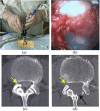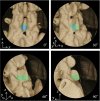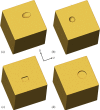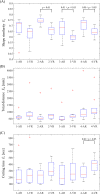Augmented Endoscopic Images Overlaying Shape Changes in Bone Cutting Procedures
- PMID: 27584732
- PMCID: PMC5008631
- DOI: 10.1371/journal.pone.0161815
Augmented Endoscopic Images Overlaying Shape Changes in Bone Cutting Procedures
Abstract
In microendoscopic discectomy for spinal disorders, bone cutting procedures are performed in tight spaces while observing a small portion of the target structures. Although optical tracking systems are able to measure the tip of the surgical tool during surgery, the poor shape information available during surgery makes accurate cutting difficult, even if preoperative computed tomography and magnetic resonance images are used for reference. Shape estimation and visualization of the target structures are essential for accurate cutting. However, time-varying shape changes during cutting procedures are still challenging issues for intraoperative navigation. This paper introduces a concept of endoscopic image augmentation that overlays shape changes to support bone cutting procedures. This framework handles the history of the location of the measured drill tip as a volume label and visualizes the remains to be cut overlaid on the endoscopic image in real time. A cutting experiment was performed with volunteers, and the feasibility of this concept was examined using a clinical navigation system. The efficacy of the cutting aid was evaluated with respect to the shape similarity, total moved distance of a cutting tool, and required cutting time. The results of the experiments showed that cutting performance was significantly improved by the proposed framework.
Conflict of interest statement
The authors have declared that no competing interests exist.
Figures












Similar articles
-
Computer-assisted and robot-assisted technologies to improve bone-cutting accuracy when integrated with a freehand process using an oscillating saw.J Bone Joint Surg Am. 2010 Sep 1;92(11):2076-82. doi: 10.2106/JBJS.I.00457. J Bone Joint Surg Am. 2010. PMID: 20810857
-
Impact of a self-developed planning and self-constructed navigation system on skull base surgery: 10 years experience.Acta Otolaryngol. 2007 Apr;127(4):403-7. doi: 10.1080/00016480601002104. Acta Otolaryngol. 2007. PMID: 17453461
-
Preliminary study on magnetic tracking-based planar shape sensing and navigation for flexible surgical robots in transoral surgery: methods and phantom experiments.Int J Comput Assist Radiol Surg. 2018 Feb;13(2):241-251. doi: 10.1007/s11548-017-1672-8. Epub 2017 Oct 5. Int J Comput Assist Radiol Surg. 2018. PMID: 28983750
-
Computer assisted surgery for total knee arthroplasty.Acta Orthop Belg. 2002 Jun;68(3):215-30. Acta Orthop Belg. 2002. PMID: 12152368 Review.
-
Workflow and simulation of image-to-physical registration of holes inside spongy bone.Int J Comput Assist Radiol Surg. 2017 Aug;12(8):1425-1437. doi: 10.1007/s11548-017-1594-5. Epub 2017 May 6. Int J Comput Assist Radiol Surg. 2017. PMID: 28478518 Review.
Cited by
-
A novel noise filtered and occlusion removal: navigational accuracy in augmented reality-based constructive jaw surgery.Oral Maxillofac Surg. 2018 Dec;22(4):385-401. doi: 10.1007/s10006-018-0719-5. Epub 2018 Sep 11. Oral Maxillofac Surg. 2018. PMID: 30206745
-
Review of Enhanced Handheld Surgical Drills.Crit Rev Biomed Eng. 2023;51(6):29-50. doi: 10.1615/CritRevBiomedEng.2023049106. Crit Rev Biomed Eng. 2023. PMID: 37824333 Free PMC article. Review.
References
-
- Foley KT, Smith MM, Micro endoscopic discectomy. Tech Neurosurg. 1997;3:301–7.
-
- Righesso O, Falavigna A, Avanzi A. Comparison of open discectomy with microendoscopic discectomy in lumbar disc herniations: results of a randomized controlled trial. Neurosurgery. 2007;61:545–549. - PubMed
-
- Nakagawa H, Yoshida M, Maia K. Microendoscopic discectomy (MED) for surgical management of lumbar disc disease: technical note. Int J Spine Surg. 2005;2.
-
- Helm P, Teichman R, Hartmann S, Simon D. Spinal navigation and imaging: history, trends and future. IEEE Trans Med Imag. 2015;34:1738–46. - PubMed
MeSH terms
LinkOut - more resources
Full Text Sources
Other Literature Sources
Medical

